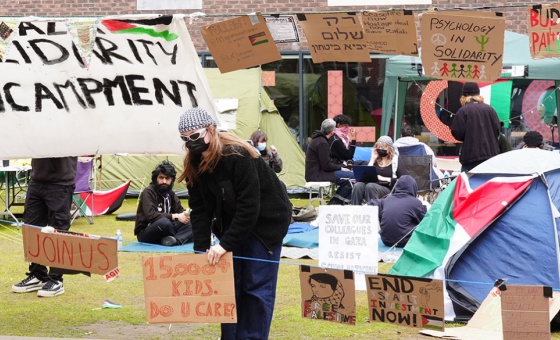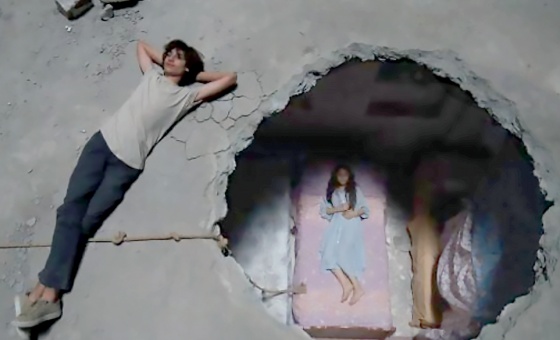This is the last article you can read this month
You can read more article this month
You can read more articles this month
Sorry your limit is up for this month
Reset on:
Please help support the Morning Star by subscribing here
Soufiane Ababri: Their mouths were full of bumblebees but it was me who was pollinated
The Curve, Barbican
SINCE the so-called Arab Spring of 2011, Morocco has seen a growing social movement that has managed to mobilise large numbers of citizens around socio-economic, political and identity demands.
Within those groups, activists who identified as LGBTQI+ brought forward necessary discussions around sexual orientation and the rights of that specific community within contemporary Morocco and in the wider Arab world.
Moroccan artist Soufiane Ababri (b1985) has added his own voice to the struggle with a dazzling art commission currently at the Barbican’s Curve Gallery — his first solo exhibition at a major British institution.
This show attempts to subvert the Western canon of gay subculture by inspiringly focusing on gay desires, play, sex, and LGBTQI+ identities.
The exhibition, with its suggestive title Their Mouths Were Tull of Bumblebees, But it Was Me Who Was Pollinated, was created around the curved shape of the gallery space, which reminded the artist of the shape of the letter “Zayin.”
This is the first letter of the word “Zamel,” a derogatory term for gay men derived from “Zamil,” meaning close or intimate friend.
Ababri’s full use of bright colours, not only in his striking drawings but also by adding suggestive red lights throughout the show, emphasised a recurrent idea of collective friendship and fun, inhabiting many of the spaces, where historically the LGBTQI+ community has expressed their sense of freedom, from bedrooms, bars and cabarets to discotheques, clubs and raves.
As you enter the space you are immediately confronted by a large-scale, silver-metallic string curtain hanging from the ceiling that suggests a sense of enclosure and veiling but also eroticism. The darkened space of the Curve is immersed in blood-red lights with just the images illuminated with white light.
The experience is quite arresting and precedes the visual impact of the actual drawings: scenes where naked men interact in beds, discos or communal spaces, dancing, reading, cuddling, or just being there.
For example in Bedwork, Men in the Sun depicts a naked man, seen from the back in a dance pose, holding a portable media player playing an Arab song, while his partner, wearing underpants and socks, watches in repose from a sheetless, grey mattress.
The pink background and details in the work, like a magazine titled New in The Sun and the small speakers, convey elements that seek to challenge traditional representations of intimacy and sexuality.
According to Ababri, these drawings have been inspired by a 13th-century illustration by Yahya ibn Mahmud al-Wasiti that depicts a tender moment between two men holding hands and looking into each other’s eyes.
One can see the inspiration in many of these works, including in Bedwork, La Reparation, where a man in a violet top caresses a male friend who’s sustained a bloody wound to his head. There is tenderness, friendship and resistance in that moving pose, implying an aftermath of a homophobic attack.
The multicoloured circles in the background make the viewer ponder how, in spite of violence and attacks gay men endure, there is often rebellion in the form of play and enjoyment — not letting anybody bring them down.
Another favourite of mine is Bedwork: Between two paragraphs of Oscar Wilde’s reading. Beautifully drawn in red, brown and green, where a lighter central circle frames the act of a man taking off his underwear. The knees of another man just show along the left edge of the drawing, suggesting an imminent sexual encounter. There’s also Oscar Wilde’s The Ballad of Reading Gaol open and lying centrally, a poignant reference to the persecution and imprisonment the iconic gay writer endured for his homosexuality, which many gay men face today in north Africa and elsewhere.
In his series of drawings and installations, Ababri repeatedly questions relationships of power, domination, and the Western canon of its perception and depiction, by making space for joy, eroticism and a celebration of gay intimacy and solidarity.
This is an uplifting exhibition that salutes queer resistance through kaleidoscopic colour, the male body and affirmation of love and emancipation.
Soufiane Ababri: Their Mouths Were Full of Bumblebees, But it Was Me Who Was Pollinated is at The Curve’s Barbican Centre until June 30 2024 and it is FREE! www.barbican.org.uk/artgallery











